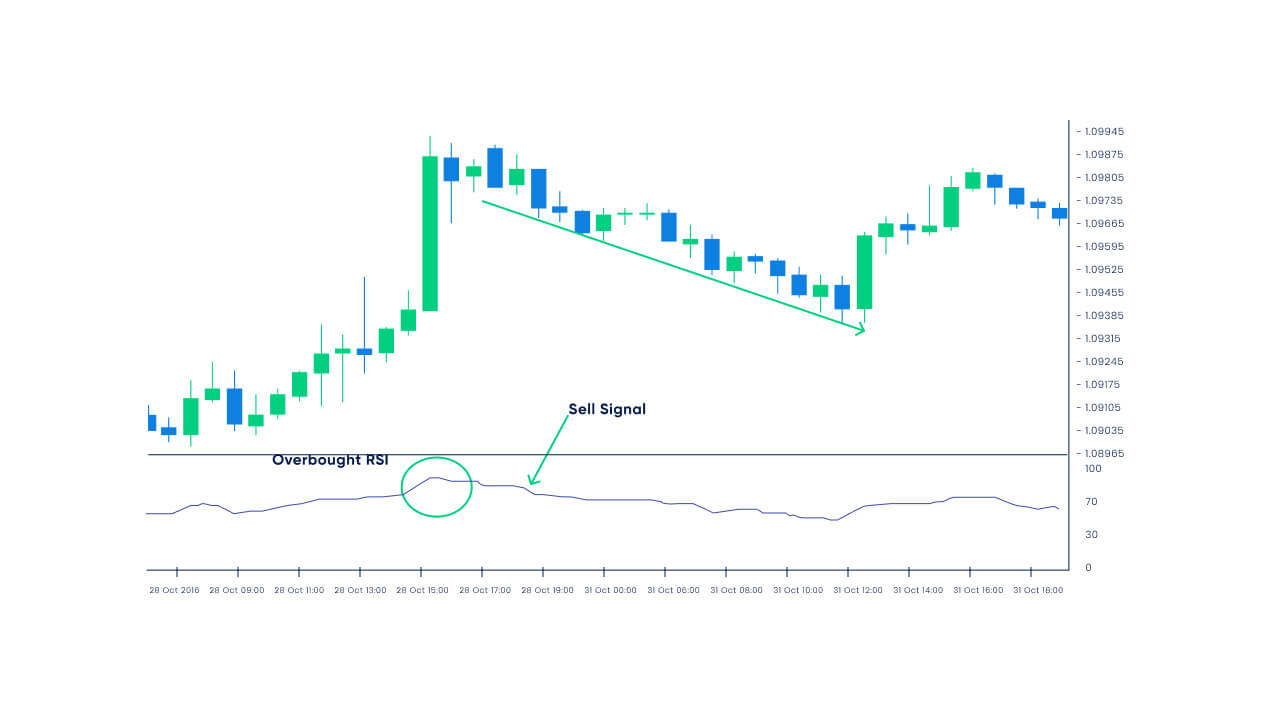RSI is one of the most commonly and popularly used forex indicators for intraday traders. It provides information regarding the degree to which forex prices have changed in a specific time period.
In this article, we learn how RSI can be used for intraday trading.
What is Relative Strength Index (RSI)?
Relative Strength Index (RSI) is a technical indicator that provides values between 0 to 100 to indicate oversold and overbought market conditions. It helps traders find the ideal entry and exit levels in trending markets.
- When the RSI is above 70, it indicates oversold market conditions and signals traders to sell a trade or open short positions due to the expected downtrend.
- When the RSI is below 30, it indicates overbought market conditions and signals traders to buy trade or open long positions due to the expected uptrend.

Using RSI for day trading and intraday
Traders use RSI to generate the right intraday and day trading signals. Since both intraday and day trading are short-term trading types, the RSI is able to set different time periods in which you can identify the market momentum in minute charts, hourly charts and daily charts.
RSI Day Trading Strategy
You can use the RSI indicator in day trading using its default time period set at 14 periods. This helps swing traders place multiple orders in a single trading day and profit from the same. However, you can also use different time period settings if the 14 period setting is not suitable. You can either increase your timeframe, like to 20 periods or decrease it to 7 periods. The lower the time frame, the higher the price sensitivity of the indicator to price changes.
- If you are a short-term trader like a swing or day trader, you can choose anywhere between 9 to 11 period timeframes.
- If you are a medium-term trader, like a fundamental trader, then you can stick with the default timeframe of 14 periods.
- If you are a long-term trader like a position trader, you can choose a higher timeframe between 20 to 30 periods.

RSI Intraday Strategy
In the intraday strategy, you can again choose the timeframe you want to trade according to the acceptable trading noise (price fluctuations). A noise trader is someone who makes trading decisions based on the trend’s direction and strength, and hence RSI helps them during intraday trading.
Most commonly, intraday traders only make short-term trades after choosing a lower timeframe. This provides you with early buy and sell signals in the trending market by determining if the current market is overbought or oversold.
- An overbought market is when the currency pair prices are trading above their fair value and can reverse anytime, providing traders with ideal exit levels.
- An oversold market is when the currency pair prices are trading below their fair value and can reverse anytime, providing traders with ideal entry levels.

Top RSI intraday trading strategies
Trendlines
You can trade with RSI trendlines by connecting the highest and lowest price levels on the trading chart. Draw an RSI uptrend by connecting three or more highs on the RSI line. An RSI downtrend is formed by connecting three or more lows on the RSI line as it is falling. When the RSI trendline breaks, it indicates that the market can either continue or reverse.
- If the previous trend has existed for a while depicting a strong market trend, the RSI trendline provides a continuation signal and helps traders place orders in favour of the market.
- If the previous trend has not formed any new highs or lows in the last few trading periods depicting a weak trend, it provides traders with a reversal signal and helps them place orders against the market.
Divergence
Divergence refers to a change in the current price movement in the forex market. RSI forms a bearish or bullish divergence in the market based on the current price movement.
- An RSI bearish divergence is formed when the currency pair prices form higher highs whereas the RSI falls and forms lower highs, indicating a bearish divergence and signalling traders to short the trade.
- An RSI bullish divergence is formed when the currency pair prices form lower lows, and the RSI rises and forms higher lows, indicating a bullish divergence and signalling traders to long the trade.
MACD
Using RSI with Moving Average Convergence Divergence (MACD) also helps intraday and day traders make ideal buy and sell orders. The two indicators are used on a 15-minute chart. When the RSI moves ahead from the oversold condition giving traders a buy signal, and the MACD leads to a bullish crossover, it confirms the uptrend signal and enables traders to place better long orders.
On the other hand, when the RSI moves away from the oversold condition giving traders a sell signal, and the MACD leads to a bearish crossover, it confirms the downtrend signal and enables traders to place better short orders.
Instead of using RSI alone, when traders combine it with an indicator like MACD, the buying and selling trading signals provided by the RSI are confirmed, and traders are able to make better and more informed trading decisions.

Start with RSI forex trading today
Both expert and beginner traders can use RSI trading due to its simplicity and ease of use. It helps in determining if the prices are trending, ranging or reversing. Start trading with our platform today and use the RSI indicator independently or combine it with other indicators
Disclaimer: All material published on our website is intended for informational purposes only and should not be considered personal advice or recommendation. As margin FX/CFDs are highly leveraged products, your gains and losses are magnified, and you could lose substantially more than your initial deposit. Investing in margin FX/CFDs does not give you any entitlements or rights to the underlying assets (e.g. the right to receive dividend payments). CFDs carry a high risk of investment loss.




